Frozen Shoulder and Acupuncture: A Comprehensive Guide
Frozen shoulder, medically known as adhesive capsulitis, is a debilitating condition characterized by stiffness, pain, and limited range of motion in the shoulder joint. It affects approximately 2-5% of the general population, with a higher prevalence among individuals aged 40-60, particularly women and those with certain medical conditions like diabetes or thyroid disorders. This article explores the causes, symptoms, and treatment options for frozen shoulder, with a particular focus on acupuncture for frozen shoulder as a natural and effective therapy.
- What is Frozen Shoulder?
- Definition and Overview
- Causes and Risk Factors
- Symptoms of Frozen Shoulder
- Diagnosis
- Conventional Treatments for Frozen Shoulder
- Acupuncture: An Ancient Solution for Modern Pain
- What is Acupuncture?
- How Acupuncture Works for Frozen Shoulder
- Key Acupoints for Acupuncture in Treating Frozen Shoulder
- Benefits of Acupuncture for Frozen Shoulder
- What to Expect During an Acupuncture Session
- Initial Consultation
- The Treatment Process
- Frequency and Duration
- Scientific Evidence Supporting Acupuncture for Frozen Shoulder
- Risks and Considerations
- Complementary Therapies for Frozen Shoulder
- Lifestyle Tips for Managing Frozen Shoulder
- Choosing an Acupuncturist
- Acupuncture vs. Other Treatments
- Conclusion
Frozen shoulder progresses through three stages: freezing, frozen, and thawing. Each phase presents unique challenges, from initial pain and stiffness to severe mobility restrictions and eventual recovery. Conventional treatments include physical therapy, corticosteroids, and, in severe cases, surgery. However, many individuals seek alternative therapies like acupuncture to manage pain and restore function without invasive procedures.
Maybe You Need:
In this guide, we’ll dive into the science behind frozen shoulder, the principles of acupuncture, and how this ancient practice can alleviate symptoms. We’ll also discuss the benefits, risks, and what to expect during acupuncture sessions, supported by research and expert insights.
What is Frozen Shoulder?
Definition and Overview
Frozen shoulder occurs when the capsule surrounding the shoulder joint thickens and tightens, restricting movement and causing pain. The condition often develops gradually and can last from several months to years if untreated. While the exact cause remains unclear, several factors contribute to its onset.
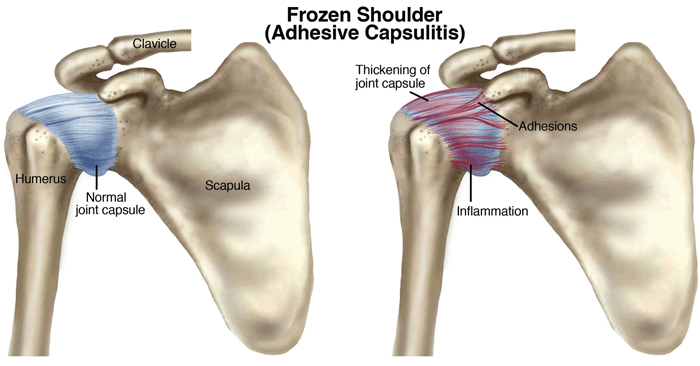
Causes and Risk Factors
Several factors increase the likelihood of developing frozen shoulder:
- Age and Gender: Most common in individuals aged 40-60, with women being more susceptible.
- Medical Conditions: Diabetes, thyroid disorders, and cardiovascular disease are linked to higher risks.
- Injury or Immobility: Prolonged shoulder immobility due to surgery, injury, or conditions like stroke can trigger adhesive capsulitis.
- Autoimmune Factors: Some evidence suggests an autoimmune component, where the body’s immune system attacks the shoulder capsule.
Symptoms of Frozen Shoulder
The symptoms vary depending on the stage:
- Freezing Stage (2-9 months): Gradual onset of shoulder pain, especially at night, with increasing stiffness.
- Frozen Stage (4-12 months): Pain may decrease, but stiffness worsens, severely limiting movement.
- Thawing Stage (5-24 months): Gradual improvement in mobility, though full recovery may take time.
Common symptoms include difficulty lifting the arm, reaching behind the back, or performing daily tasks like dressing or driving.
Diagnosis
Diagnosing frozen shoulder involves a physical examination, medical history review, and sometimes imaging tests like X-rays or MRIs to rule out other conditions, such as rotator cuff injuries or arthritis. A hallmark of frozen shoulder is restricted active and passive range of motion, meaning the shoulder cannot move freely even with assistance.
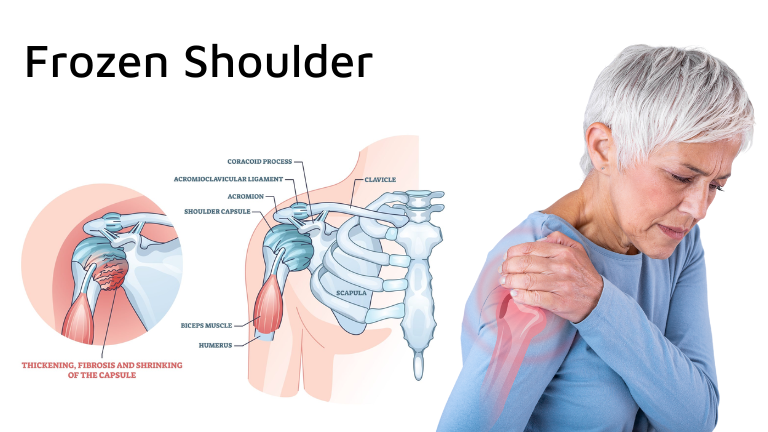
Conventional Treatments for Frozen Shoulder
Before exploring acupuncture, it’s essential to understand standard treatments for frozen shoulder:
- Physical Therapy: Gentle stretching and strengthening exercises to improve mobility.
- Medications: Nonsteroidal anti-inflammatory drugs (NSAIDs) or corticosteroid injections to reduce pain and inflammation.
- Hydrodilatation: Injecting fluid into the shoulder joint to stretch the capsule.
- Surgery: In severe cases, arthroscopic surgery or manipulation under anesthesia may be required.
While effective for some, these treatments can have limitations, such as side effects from medications or the need for prolonged recovery after surgery. This has led many to explore alternative therapies like acupuncture.
Acupuncture: An Ancient Solution for Modern Pain
What is Acupuncture?
Acupuncture is a traditional Oriental medicine (TOM) practice that involves inserting thin, sterile needles into specific points on the body, known as acupoints, to restore balance and promote healing. According to TOM, the body’s energy flows through meridians. Blockages or imbalances in energy can lead to pain and illness. Acupuncture aims to correct these imbalances.
In the context of frozen shoulder, acupuncture targets acupoints related to the shoulder, neck, and upper back to reduce pain, inflammation, and muscle tension while improving blood flow and mobility.
How Acupuncture Works for Frozen Shoulder
Acupuncture is believed to work through several mechanisms:
- Pain Relief: Stimulating acupoints triggers the release of endorphins, the body’s natural painkillers.
- Reduced Inflammation: Acupuncture may modulate the immune system and reduce inflammation in the shoulder capsule.
- Improved Blood Flow: Needling enhances circulation, delivering oxygen and nutrients to the affected area.
- Muscle Relaxation: Acupuncture can relieve muscle spasms and tension, improving range of motion.

Key Acupoints for Acupuncture in Treating Frozen Shoulder
Acupuncture for frozen shoulder targets specific acupoints to alleviate pain, reduce stiffness, and improve range of motion. These points are strategically chosen based on traditional Chinese medicine (TOM) principles, which emphasize restoring the flow of energy and blood through meridians. Below are the key acupoints commonly used by licensed acupuncturists to treat frozen shoulder, along with their locations, functions, and therapeutic benefits.
- LI15 (Jianyu) – Large Intestine 15
Location: On the shoulder, in the depression anterior and inferior to the acromion when the arm is abducted.
Function:
- Relieves shoulder pain and stiffness.
- Promotes circulation in the shoulder joint.
- Enhances range of motion.
Why It’s Used: LI15 is a primary local point for shoulder conditions like frozen shoulder. It directly targets the affected area, reducing inflammation and relaxing tight muscles.
Clinical Note: Often used with electroacupuncture to enhance pain relief and muscle relaxation.

- SI9 (Jianzhen) – Small Intestine 9
Location: On the posterior aspect of the shoulder, 1 cun (approximately one thumb’s width) above the end of the axillary fold when the arm is adducted.
Function:
- Alleviates shoulder and arm pain.
- Relaxes the rotator cuff muscles.
- Improves blood flow to the shoulder joint.
Why It’s Used: SI9 is effective for posterior shoulder pain and stiffness, common in the freezing and frozen stages of adhesive capsulitis.
Clinical Note: Frequently combined with LI15 for comprehensive shoulder treatment.
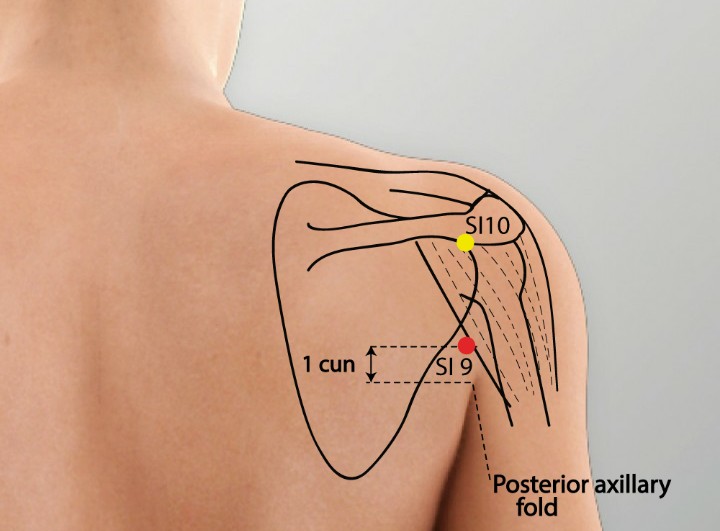
- GB21 (Jianjing) – Gallbladder 21
Location: At the highest point of the shoulder, midway between the C7 vertebra (base of the neck) and the acromion.
Function:
- Relieves neck and shoulder tension.
- Reduces muscle spasms.
- Promotes relaxation and stress relief.
Why It’s Used: GB21 addresses referred pain and tension in the upper trapezius, which often accompanies frozen shoulder due to compensatory muscle strain.
Clinical Note: Use with caution in pregnant patients, as this point is contraindicated in pregnancy due to its potential to induce labor.
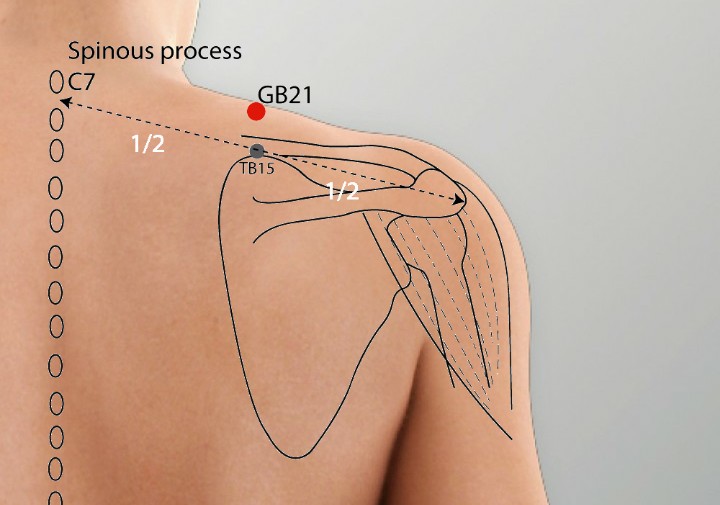
- LI14 (Binao) – Large Intestine 14
Location: On the lateral side of the upper arm, at the insertion of the deltoid muscle, about 7 cun above the elbow.
Function:
- Eases arm and shoulder pain.
- Improves circulation in the upper limb.
- Supports shoulder joint mobility.
Why It’s Used: LI14 is a secondary point that complements LI15 by addressing pain that radiates down the arm, a common symptom in frozen shoulder.
Clinical Note: Often used in combination with distal points to enhance overall treatment efficacy.

- TE14 (Jianliao) – Triple Energizer 14
Location: On the shoulder, in the depression posterior and inferior to the acromion when the arm is abducted.
Function:
- Reduces shoulder joint pain and stiffness.
- Enhances local circulation.
- Supports rotator cuff function.
Why It’s Used: TE14 is particularly effective for lateral shoulder pain and restricted abduction, key issues in frozen shoulder.
Clinical Note: Pairs well with LI15 and SI9 for a synergistic effect on shoulder mobility.
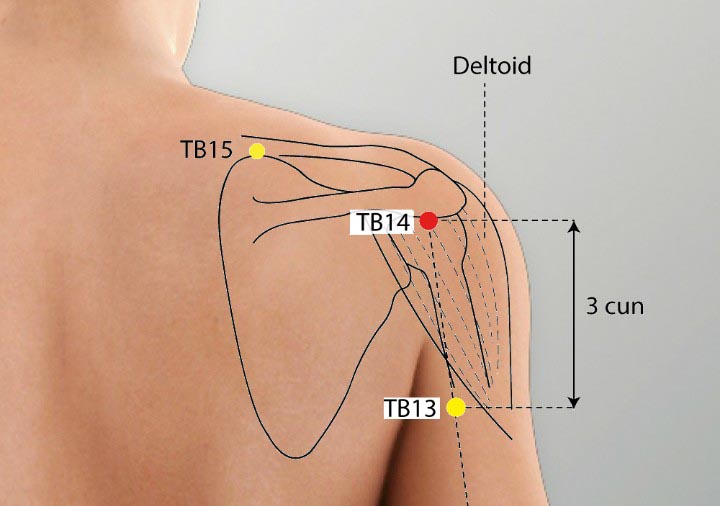
- LI4 (Hegu) – Large Intestine 4
Location: On the hand, in the webbing between the thumb and index finger, at the highest point of the muscle when the thumb and finger are pressed together.
Function:
- Acts as a powerful pain-relieving point.
- Promotes overall energy
- Reduces inflammation and stress.
Why It’s Used: LI4 is a distal point that helps manage pain and inflammation throughout the body, including the shoulder. It’s often used to enhance the effects of local shoulder points.
Clinical Note: Contraindicated in pregnancy due to its strong stimulating effect.

- ST38 (Tiaokou) – Stomach 38
Location: On the lower leg, 8 cun below the knee, midway between the fibula and tibia.
Function:
- Treats shoulder pain and stiffness remotely.
- Improves Energy and blood flow to the shoulder.
- Relaxes tendons and ligaments.
Why It’s Used: ST38 is a distal point used in TOM to treat frozen shoulder by addressing the shoulder through the Stomach meridian, which connects to the upper body.
Clinical Note: Often needled with manipulation to stimulate the shoulder remotely, especially effective in the frozen stage.
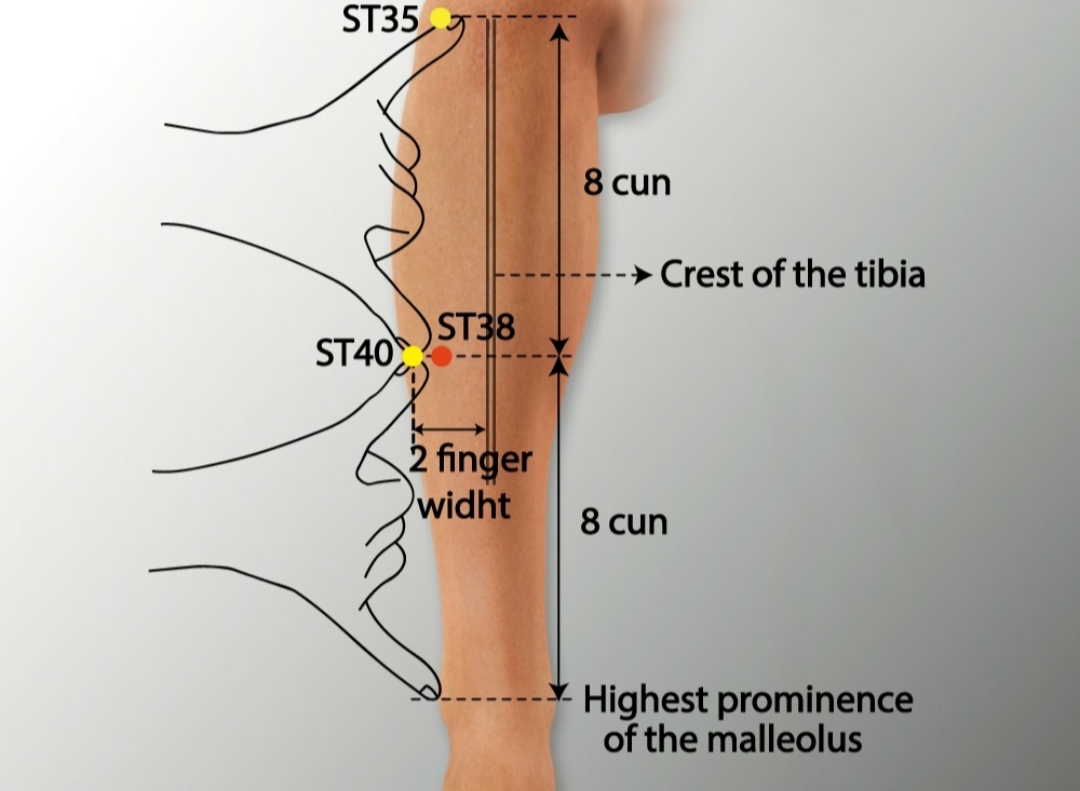
How These Acupoints Are Used in Treatment
- Local Points (LI15, SI9, TE14, GB21): Target the shoulder directly to reduce pain, inflammation, and stiffness in the joint and surrounding muscles.
- Distal Points (LI4, ST38): Address systemic imbalances, enhance overall Energy flow, and provide additional pain relief by stimulating distant areas connected via meridians.
- Combination Therapy: Acupuncturists often combine local and distal points for a holistic approach. For example, needling LI15 and SI9 locally while adding LI4 and ST38 distally can maximize pain relief and mobility.
- Techniques: Practitioners may use manual needling, electroacupuncture, or adjunct therapies like moxibustion (applying heat to acupoints) or cupping to enhance results.
Benefits of Acupuncture for Frozen Shoulder
Acupuncture offers several advantages for individuals with frozen shoulder:
- Non-Invasive: Unlike surgery, acupuncture involves minimal risk and no recovery time.
- Holistic Approach: It addresses both physical and emotional aspects of pain, reducing stress and improving overall well-being.
- Customizable: Treatments are tailored to the individual’s symptoms and stage of frozen shoulder.
- Minimal Side Effects: When performed by a licensed practitioner, acupuncture is safe with few adverse effects.
Studies, such as a 2016 meta-analysis published in Pain Medicine, found that acupuncture significantly reduced pain and improved shoulder function in patients with adhesive capsulitis compared to sham acupuncture or no treatment.
What to Expect During an Acupuncture Session
Initial Consultation
Your first acupuncture session begins with a thorough consultation. The practitioner will assess your medical history, symptoms, and lifestyle factors. They may examine your shoulder’s range of motion and ask about pain patterns.
The Treatment Process
- Preparation: You’ll lie on a treatment table, and the practitioner will sterilize the skin around the targeted acupoints.
- Needle Insertion: Thin needles are inserted into specific points, often around the shoulder, arm, or distant areas like the hands or feet. You may feel a slight pinch or tingling sensation.
- Needle Retention: Needles are left in place for 15-30 minutes while you relax. Some practitioners use electroacupuncture, where a mild electric current is applied to enhance stimulation.
- Post-Treatment: Needles are removed, and the practitioner may recommend follow-up sessions or complementary therapies like cupping or moxibustion.
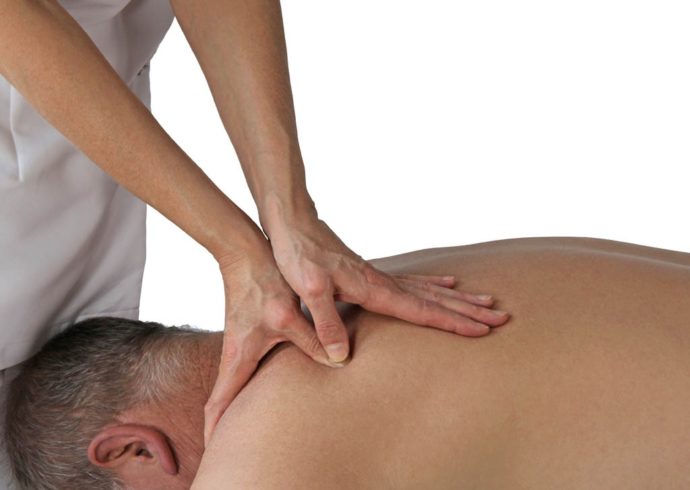
Frequency and Duration
For frozen shoulder, acupuncture is typically administered 1-2 times per week for 6-12 weeks, depending on the severity and stage of the condition. Many patients report improvement after 4-6 sessions, though chronic cases may require longer treatment.
Scientific Evidence Supporting Acupuncture for Frozen Shoulder
Research supports acupuncture’s efficacy for frozen shoulder:
- A 2018 study in The Journal of Alternative and Complementary Medicine found that acupuncture combined with physical therapy improved pain scores and range of motion more than physical therapy alone.
- A 2020 randomized controlled trial in Acupuncture in Medicine reported that electroacupuncture significantly reduced pain and stiffness in patients with frozen shoulder.
- A systematic review in Evidence-Based Complementary and Alternative Medicine (2019) concluded that acupuncture is a safe and effective adjunctive therapy for adhesive capsulitis.
While more large-scale studies are needed, existing evidence suggests acupuncture is a valuable option for managing frozen shoulder symptoms.
Risks and Considerations
Acupuncture is generally safe when performed by a licensed practitioner. However, potential risks include:
- Minor Discomfort: Temporary soreness, bruising, or tingling at needle sites.
- Infection: Rare if sterile needles are used.
- Contraindications: Acupuncture may not be suitable for individuals with bleeding disorders or those taking blood thinners.
Always choose a certified acupuncturist with experience treating musculoskeletal conditions. Discuss your medical history to ensure acupuncture is appropriate for you.
Complementary Therapies for Frozen Shoulder
Acupuncture is often combined with other therapies to enhance results:
- Physical Therapy: Stretching and strengthening exercises complement acupuncture by improving mobility.
- Cupping Therapy: Suction cups applied to the skin can reduce muscle tension and improve circulation.
- Moxibustion: Burning mugwort near acupoints warms the area, promoting blood flow.
- Massage: Therapeutic massage can relieve tightness and support recovery.
Lifestyle Tips for Managing Frozen Shoulder
- Stay Active: Gentle shoulder exercises prevent further stiffness.
- Apply Heat: Warm compresses can relax muscles and improve blood flow.
- Manage Stress: Stress can exacerbate pain, so practices like meditation or yoga may help.
- Healthy Diet: Anti-inflammatory foods like fatty fish, nuts, and leafy greens support overall healing.

Choosing an Acupuncturist
When seeking acupuncture for frozen shoulder, consider the following:
- Credentials: Look for a licensed acupuncturist certified by organizations like the National Certification Commission for Acupuncture and Oriental Medicine (NCCAOM).
- Experience: Choose a practitioner with expertise in treating musculoskeletal conditions.
- Reviews and Referrals: Check online reviews or ask for recommendations from healthcare providers.
- Communication: Ensure the practitioner listens to your concerns and explains the treatment plan clearly.
Acupuncture vs. Other Treatments
| Treatment | Pros | Cons |
| Acupuncture | Non-invasive, minimal side effects, holistic | Requires multiple sessions, not covered by all insurance |
| Physical Therapy | Improves mobility, non-invasive | May be painful, requires commitment |
| Corticosteroids | Quick pain relief | Side effects, temporary benefits |
| Surgery | Effective for severe cases | Invasive, long recovery time |
Acupuncture stands out for its balance of efficacy, safety, and minimal invasiveness, making it an attractive option for many patients.
Conclusion
Frozen shoulder can be a painful and frustrating condition, but acupuncture offers a promising, non-invasive solution. By targeting specific acupoints, acupuncture reduces pain, inflammation, and stiffness while promoting natural healing. Supported by scientific research and countless patient success stories, acupuncture is a valuable addition to conventional treatments like physical therapy or medication.
If you’re considering acupuncture for frozen shoulder, consult a licensed practitioner to develop a personalized treatment plan. With consistent sessions and complementary lifestyle changes, you can regain mobility and live pain-free. For more information or to find a qualified acupuncturist, explore reputable resources or contact Fuji Wellness today, a trusted provider of acupuncture and holistic health services.
Fuji Wellness:
- Address: 132-0031 Matsushima 1-chome, 21-14, Tokyo, Japan
- Chat with us: Click here
- Email: sunnyphamsensei@gmail.com





